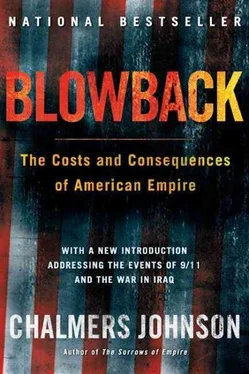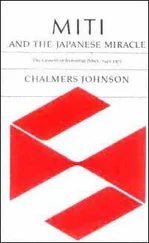Chalmers Johnson - Blowback, Second Edition - The Costs and Consequences of American Empire
Здесь есть возможность читать онлайн «Chalmers Johnson - Blowback, Second Edition - The Costs and Consequences of American Empire» весь текст электронной книги совершенно бесплатно (целиком полную версию без сокращений). В некоторых случаях можно слушать аудио, скачать через торрент в формате fb2 и присутствует краткое содержание. Год выпуска: 0101, ISBN: 0101, Издательство: Macmillan, Жанр: Старинная литература, на английском языке. Описание произведения, (предисловие) а так же отзывы посетителей доступны на портале библиотеки ЛибКат.
- Название:Blowback, Second Edition: The Costs and Consequences of American Empire
- Автор:
- Издательство:Macmillan
- Жанр:
- Год:0101
- ISBN:9780805075595
- Рейтинг книги:5 / 5. Голосов: 1
-
Избранное:Добавить в избранное
- Отзывы:
-
Ваша оценка:
- 100
- 1
- 2
- 3
- 4
- 5
Blowback, Second Edition: The Costs and Consequences of American Empire: краткое содержание, описание и аннотация
Предлагаем к чтению аннотацию, описание, краткое содержание или предисловие (зависит от того, что написал сам автор книги «Blowback, Second Edition: The Costs and Consequences of American Empire»). Если вы не нашли необходимую информацию о книге — напишите в комментариях, мы постараемся отыскать её.
Blowback, Second Edition: The Costs and Consequences of American Empire — читать онлайн бесплатно полную книгу (весь текст) целиком
Ниже представлен текст книги, разбитый по страницам. Система сохранения места последней прочитанной страницы, позволяет с удобством читать онлайн бесплатно книгу «Blowback, Second Edition: The Costs and Consequences of American Empire», без необходимости каждый раз заново искать на чём Вы остановились. Поставьте закладку, и сможете в любой момент перейти на страницу, на которой закончили чтение.
Интервал:
Закладка:
The problem for the United States was that national Communist parties had filled a leadership vacuum in colonial East Asia. To prevent much of that region, possibly even Japan, from coming under the influence of nationalistic Communist parties, the U.S. government from time to time used the sort of brutal methods to which the USSR had resorted in Eastern Europe to hang on to its sphere of influence. The clearest example of this was the role it played in South Korea after 1945, a history that has been almost totally suppressed in the United States.
South Korea has been occupied by American forces virtually continuously since the end of World War II. It was the scene of the most important armed conflict of the early Cold War years, the place where the United States and China fought each other to a standstill and froze relations with each other for two decades. Thanks to the United States and the Soviet Union, which in 1945 divided the country for their own convenience, a half century later Korea remains the last place on earth whose borders are determined by where the armies of World War II stopped. South Korea’s rise during the 1960s as a “miracle economy” and its spectacular financial collapse of 1997 were directly related to its status as a satellite of the United States.
South Korea was the first place in the postwar world where the Americans set up a dictatorial government. With the exception of its authoritarian president, Syngman Rhee, it consisted largely of former Korean collaborators with the Japanese colonialists. Despite opposition from the Korean people, America’s need for a staunchly anti-Communist regime took precedence, given the occupation of North Korea by the USSR. In 1960, after Koreans searching for democracy overthrew Rhee, the U.S. government threw its support behind Park Chung-hee, the first of three army generals who would rule from 1961 to 1993. The Americans tolerated a coup d’état by General Chun Doo-hwan in 1979 and covertly supported his orders that led to the killing of several hundred, maybe several thousand, Korean civilians at Kwangju in 1980 (probably far more people than the Chinese Communists killed in and around Tiananmen Square in 1989). In order to keep South Korea firmly under its control, during the 1980s the Americans sent as successive ambassadors two senior officials of the Central Intelligence Agency, James Lilly and Donald Gregg. Nowhere else did the United States so openly turn over diplomatic relations to representatives of its main clandestine services organization.
South Korea is today probably closer to a genuine parliamentary democracy than any country in East Asia, but no thanks to the American State Department, the Pentagon, or the CIA. It was the Korean people themselves, particularly the students of the country’s leading universities, who through demonstrations and street confrontations in 1987 finally brought a measure of democracy to their country. After the democratically elected government of Kim Young-sam took office in 1993, President Kim felt sufficiently secure to put the two surviving dictators, Chun and Roh Tae Woo, on trial. They were convicted of state terrorism, sedition, and corruption. The American press gave the trials only the most minimal coverage, while the U.S. government ignored them as a purely internal Korean affair.
The rule of Syngman Rhee and the U.S.-backed generals was merely the first instance in East Asia of the American sponsorship of dictators. The list is long, but it deserves reiteration simply because many in the United States fail to remember (if they ever knew) what East Asians cannot help but regard as a major part of our postwar legacy. U.S.-sponsored Asian dictators include:
 Chiang Kai-shek and his son Chiang Ching-kuo in Taiwan. (Taiwan started to democratize only in the 1980s after the Carter administration had broken relations with it.)
Chiang Kai-shek and his son Chiang Ching-kuo in Taiwan. (Taiwan started to democratize only in the 1980s after the Carter administration had broken relations with it.)
 Ferdinand Marcos in the Philippines (brought down by Corazon Aquino and her People Power movement after Presidents Ronald Reagan and George Bush had hailed him as a democrat).
Ferdinand Marcos in the Philippines (brought down by Corazon Aquino and her People Power movement after Presidents Ronald Reagan and George Bush had hailed him as a democrat).
 Ngo Dinh Diem (assassinated on American orders), General Nguyen Khanh, General Nguyen Cao Ky, and General Nguyen Van Thieu in Vietnam.
Ngo Dinh Diem (assassinated on American orders), General Nguyen Khanh, General Nguyen Cao Ky, and General Nguyen Van Thieu in Vietnam.
 General Lon Nol in Cambodia.
General Lon Nol in Cambodia.
 Marshals Pibul Songgram, Sarit Thanarat, Praphas Charusathien, and Thanom Kittikachorn in Thailand (where they were essentially caretakers for the huge American air bases at Udorn, Takli, Korat, and Ubon).
Marshals Pibul Songgram, Sarit Thanarat, Praphas Charusathien, and Thanom Kittikachorn in Thailand (where they were essentially caretakers for the huge American air bases at Udorn, Takli, Korat, and Ubon).
 General Suharto in Indonesia (brought to power with the help of the Central Intelligence Agency and overthrown with the help of the Pentagon’s Defense Intelligence Agency).
General Suharto in Indonesia (brought to power with the help of the Central Intelligence Agency and overthrown with the help of the Pentagon’s Defense Intelligence Agency).
Several others had careers too brief or obscure to remember clearly (for example, General Phoumi Nosavan in Laos). These men belong to the same category of petty tyrants that the former Soviet Union used to staff its satellites in Eastern Europe from 1948 to 1989 (although the Russians usually chose obedient members of the local Communist Party apparatus over militarists).
The U.S. government used economics, as well as authoritarian regimes, as a tool of empire building. Our most effective, nonmilitary policies in East Asia were to trade access to our markets for East Asian toleration of the indefinite billeting of our soldiers, aircraft, and ships in their countries. Admittedly, following the Vietnam War, the United States briefly toyed with the idea of letting its empire in East Asia go. President Jimmy Carter explored withdrawing our troops from South Korea, particularly since North and South Korea were at that point nearly indistinguishable in terms of human rights abuses and Staliniststyle development policies. But he was forestalled in 1979 by the assassination of the South Korean dictator, General Park Chung-hee, and by his inability politically to cast off one satellite just as another one, Iran, was in open rebellion against the United States. When, in the final days of the Carter administration, the Soviet Union invaded Afghanistan in order to prop up its own puppets there, any talk of giving up our empire evaporated.
During the 1980s, the last decade of the Cold War, the parallelism between the policies of the United States and the USSR continued but with a new geographical focus. Both sought to shore up or establish puppet regimes in territories that were on their borders or in adjacent regions that had long been claimed as spheres of influence. The USSR was preoccupied with Afghanistan; the United States, with Central America. Both superpowers utilized the rhetoric of the Cold War to justify their aggressive actions against much smaller states—anticapitalism for the USSR in Afghanistan, anticommunism for the United States in Guatemala, El Salvador, Nicaragua, Panama, and the island of Grenada—even though capitalism in Afghanistan and communism in Central America were both essentially absurd ideas. Propaganda apparatuses in the United States and the USSR effectively disguised from their own peoples the true roots of revolt in both regions—a religious revival in Afghanistan, opposition to oligarchies that had long fronted for American corporations in Central America.
President Reagan and his CIA director, William Casey, claimed they were trying to halt the erosion of the “free world” in the wake of the Vietnam War. Whether this was truly their strategy or merely political rhetoric has never been clear, but what could not be clearer was that, in 1981, the United States launched Vietnam-style operations in Central America and put large sums of money, often covertly raised, into supporting an insurgency against a Sandinista government in Nicaragua sympathetic to Castro’s Cuba. At the same time, superpower détente, arms control talks, and Sino-American rapprochement virtually eliminated any real threat of war between hostile camps in Europe or East Asia. While the American demonization of Castro’s Cuba ratcheted upward and the government argued vociferously that Cuban-inspired insurgencies were the hemisphere’s greatest threat, the Cold War was already essentially over. The superpowers continued it only as propaganda cover for their respective neighborhood imperialisms.
Читать дальшеИнтервал:
Закладка:
Похожие книги на «Blowback, Second Edition: The Costs and Consequences of American Empire»
Представляем Вашему вниманию похожие книги на «Blowback, Second Edition: The Costs and Consequences of American Empire» списком для выбора. Мы отобрали схожую по названию и смыслу литературу в надежде предоставить читателям больше вариантов отыскать новые, интересные, ещё непрочитанные произведения.
Обсуждение, отзывы о книге «Blowback, Second Edition: The Costs and Consequences of American Empire» и просто собственные мнения читателей. Оставьте ваши комментарии, напишите, что Вы думаете о произведении, его смысле или главных героях. Укажите что конкретно понравилось, а что нет, и почему Вы так считаете.










